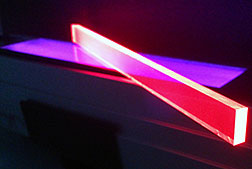- Number 437 |
- April 20, 2015
Promising future of quantum dots explored in conference

Quantum dot LSC devices under ultraviolet
illumination.
Researchers from around the world are gathering this week in Santa Fe, New Mexico to reflect on two decades of quantum dot research at a special topical conference, “20 Years of Quantum Dots at Los Alamos.” The conference is hosted by the New Mexico Consortium and its program committee includes several past and present members of the Nanotechnology and Advanced Spectroscopy Team (NanoTech team) of the Chemistry Division of DOE's Los Alamos National Laboratory.
“This research, which started two decades ago with a handful of fragments of semiconductor-doped colored glasses, has evolved into a wide-ranging program spanning different areas of quantum dot science from synthesis and spectroscopy to theory and devices,” said Victor Klimov, the NanoTech team’s leader and the founder of the Laboratory’s quantum dot program. Klimov gave a special introductory address at the conference with his personal perspective on the field’s evolution.
Quantum dots: Tiny particles with a bright future
Quantum dots have been at the center of many early developments in what is now commonly called nanoscience and nanotechnology. Quantum dots are tiny specs of semiconductor matter that are a few nanometers across. The focus of the nanotech team’s research has been on particles fabricated via colloidal chemistry, known as colloidal or nanocrystal quantum dots. “Because of their size-controlled electronic properties and chemical flexibility, quantum dots can be viewed as ‘artificial atoms’ that can be engineered on demand to address a specific physical problem or a need of a certain application,” Klimov said.
Over nearly two decades, quantum dot scientists have driven the evolution of colloidal quantum dots from a subject of laboratory curiosity to a versatile class of materials exploited in a wide range of emerging technologies such as e-book readers and television sets.
Quantum dot lasers and light emitting diodes
The Los Alamos NanoTech team’s research has revealed many unexpected and unusual optical and physical properties of quantum dots, showing that they behave quite differently than bulk solids when it comes to capturing photons or emitting light.
Los Alamos’ quantum dot team also has been responsible for several important advances in the area of quantum dot light emitting diodes (LEDs). A 2004 Nature report demonstrated an elegant approach to activating light emission from the quantum dots using “wireless” excitation via exciton transfer from a proximal quantum well. Additionally, the Los Alamos team made the first practical demonstration of a new all-inorganic quantum dot LED architecture, which holds promise for the realization of robust and durable devices with highly stable performance.
Most recently, the Laboratory quantum dot researchers successfully exploited the ideas of “interface engineering” for alleviating the problem of efficiency roll-off at high currents in quantum dot LEDs.
Two for the price of one
An important breakthrough reported by the NanoTech team is discovery of carrier multiplication in quantum dots, the process whereby absorption of a single photon produces multiple electron-hole pairs. Potentially, it can boost the efficiency of solar-energy conversion in both photovoltaics and generation of solar fuels. The pioneering work of the Los Alamos team transformed carrier multiplication from a theoretical concept for exceeding fundamental limits in solar-energy conversion into a technological reality.
Watch this video to learn more on quantum dots.
Center for Advanced Solar Photophysics
Capitalizing on advances in understanding of how nanoparticles interact with light, the Los Alamos quantum dot team in 2008 developed a proposal that led to establishment of the Center for Advanced Solar Phototophysics, (CASP) led by Klimov, and funded in 2009 by the U.S. Department of Energy as part of the nationwide initiative in Energy Frontier Research Centers. The mission of CASP is to harness the unique properties of quantum-confined semiconductor materials for facilitating the realization of the next generation of low-cost, high-efficiency solar photoconversion systems.
The team
Over the years the NanoTech team has hosted more than 80 postdocs and students including 19 Director’s and named Fellows. Several former Laboratory postdoctoral researchers have stayed at Los Alamos as staff members, applying their expertise to various problems of national security. In addition to Klimov, the NanoTech team currently includes Los Alamos scientists Jeffery Pietryga, the team’s lead chemist, and Istvan Robel, spectroscopy lab coordinator, and 14 earlier career researchers, including an Oppenheimer Postdoctoral Fellow and two Director’s Postdoctoral Fellows.Story link: http://www.lanl.gov/discover/news-release-archive/2015/April/04.13-promising-future-of-quantum-dots.php
[Nancy Ambrosiano, 505.667.0471,
nwa@lanl.gov]
